STANDARDS OF PRACTICE
The International Standards of Practice for inspecting the HVAC systems is located at www.nachi.org/sop.
FREE, ONLINE COURSE
To learn more, take InterNACHI's free, online How to Inspect HVAC Systems Course.
MECHANICAL ROOM
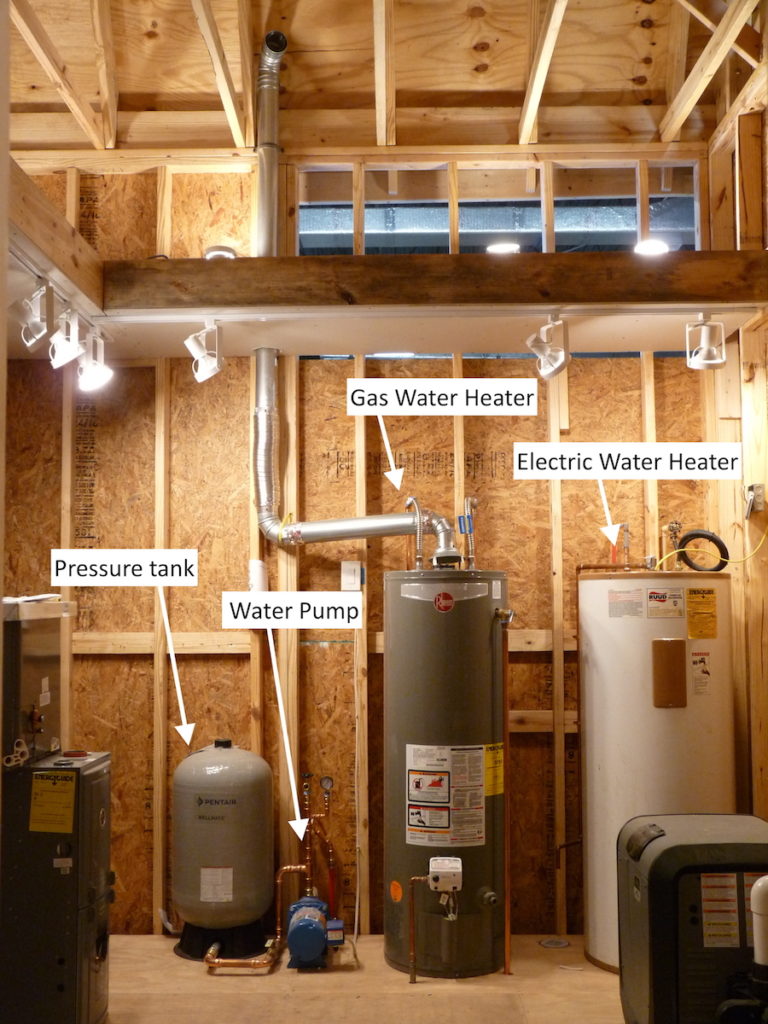
AIR HANDLER
The lower portion of the air handler has evaporator coils for cooling air. In the upper portion are electric coils for heating air.
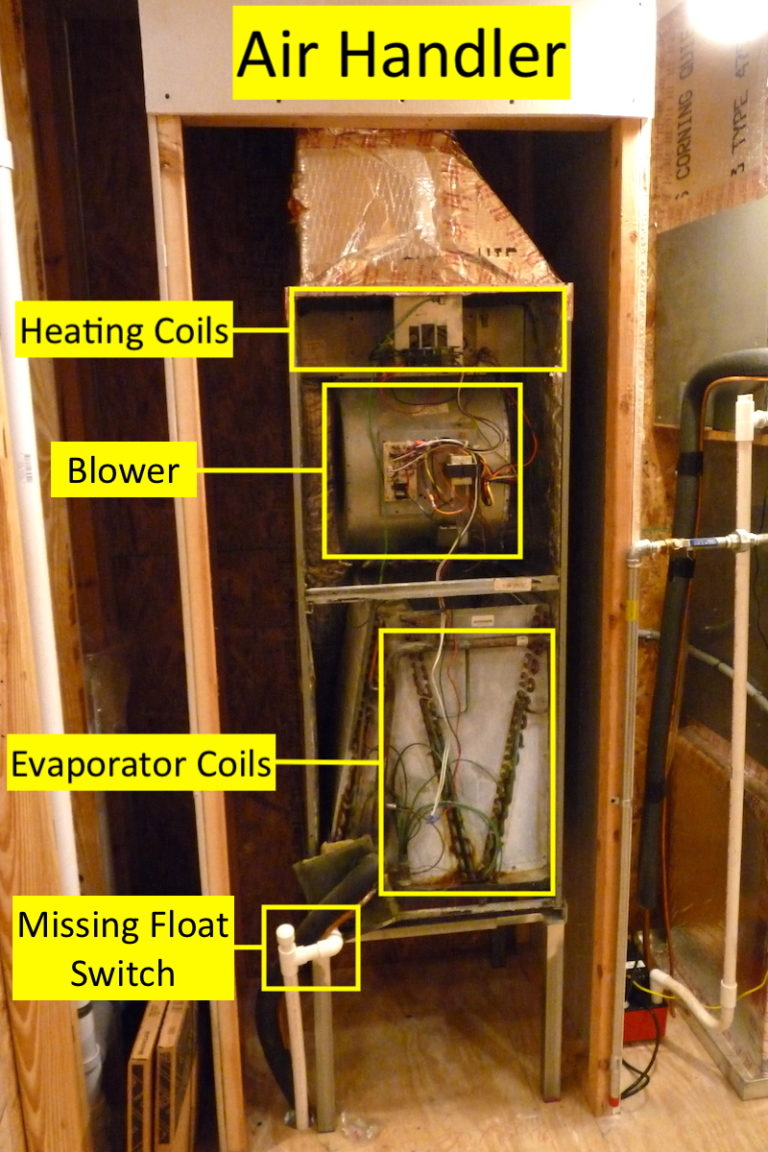
Observation
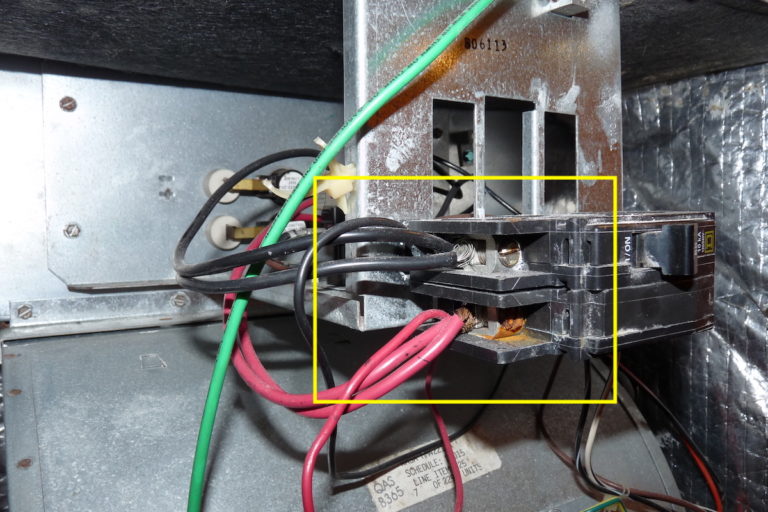
The circuit breaker has multiple wired under screws meant for one wire only. Metal parts are corroded.
Observation
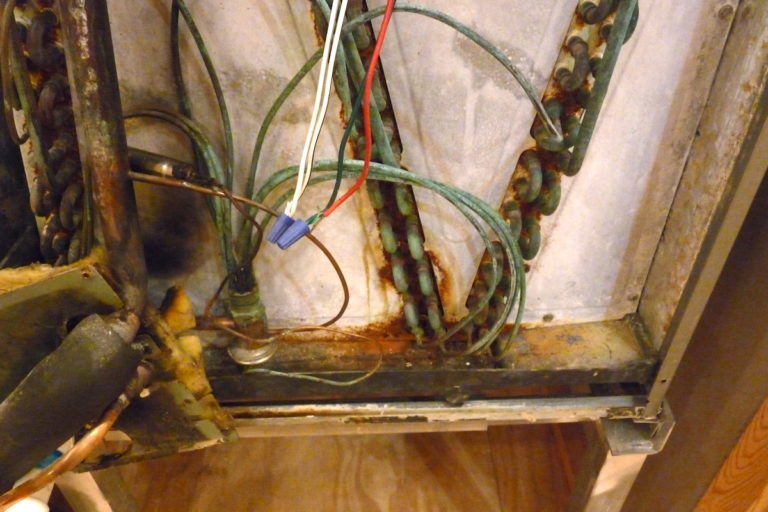
The evaporator coils are corroded.
Observation

No float switch is installed.
Observation

A hole in the ceiling violates the separation from the attic.
ELECTRIC WATER HEATER


No electrical shut off is installed.
A shut-off should be installed to allow replacement or repair of the water heater.
Observation

Exposed, inadequately-supported conductor.
Whether the conductor may be exposed, or must be installed inside armored cable or conduit varies with jurisdiction and with the potential for exposure to damage.
The conductor must be supported with cable connectors and staples in a manner similar to the rest of the home wiring.
Observation

Improper water pipe material.
Washing machine hoses are not an acceptable substitute for proper water supply pipe materials.
Observation

Improper water pipe materials, connections, and fittings.
Polybutylene (PB) has been installed in buildings across the country. It has been the subject of a large class action suit, and the recommendation is typically for replacement due to high incidence of incipient (early) failure resulting in leaking and damage. Failure has generally been connected with improper crimp installation and the development of cracks due to chemical reaction with supply water in some areas. Also, a hose clamp is an insufficient connection (PB to copper).
Observation

Observation

Both #1 and #2 have dielectric connections installed but still have different metals in contact with each other. In the presence of moisture, different metals in contact with each other can cause galvanic corrosion. In #1, brass against copper is acceptable, in #2, galvanized steel against copper is not OK. Recommend correction of #2.
Observation

Improper materials/fittings. Starting from the top (grey pipe), installed is polybutylene connected to PEX with fittings of different metals., PEX is connected to PVC with fittings of different metals. PVC is not an approved material for hot water supply pipes, and these pipes are ½” but should be ¾”.
Reduced diameter of temperature/pressure relief (TPR) valve discharge pipe.
The TPR discharge pipe must not be reduced in diameter form the Valve outlet size. Here, it has been reduced from ¾” to ½”.
Improper TPR discharge pipe termination height.
To reduce the chances of scalding anyone nearby when the TPR valve activates, TPR discharge pipes should terminate at a height no greater than 6” above the floor.
Note on water heater elements:
On a dual element residential water heater, both elements do not heat at the same time.
Starting with a tank of hot water. When hot water is used, cold water enters the bottom of the tank at the same time. This cools the lower thermostat and the lower element will heat.
If enough hot water is used to cool the upper thermostat the lower element will shut down and the upper element will heat. When the upper thermostat is satisfied it will send the power back to the lower thermostat/element.
When you use a lot of hot water but it takes a long time to heat back up, the problem is most likely with the upper thermostat/element. When hot water is depleted quickly, the problem is likely with the lower element/thermostat.
GAS-FIRED FURNACE
Most components are installed correctly on this gas-fired furnace and can be compared to the corresponding components on the gas-fired water heater located a few feet away, most of which are installed or configured in a defective manner.
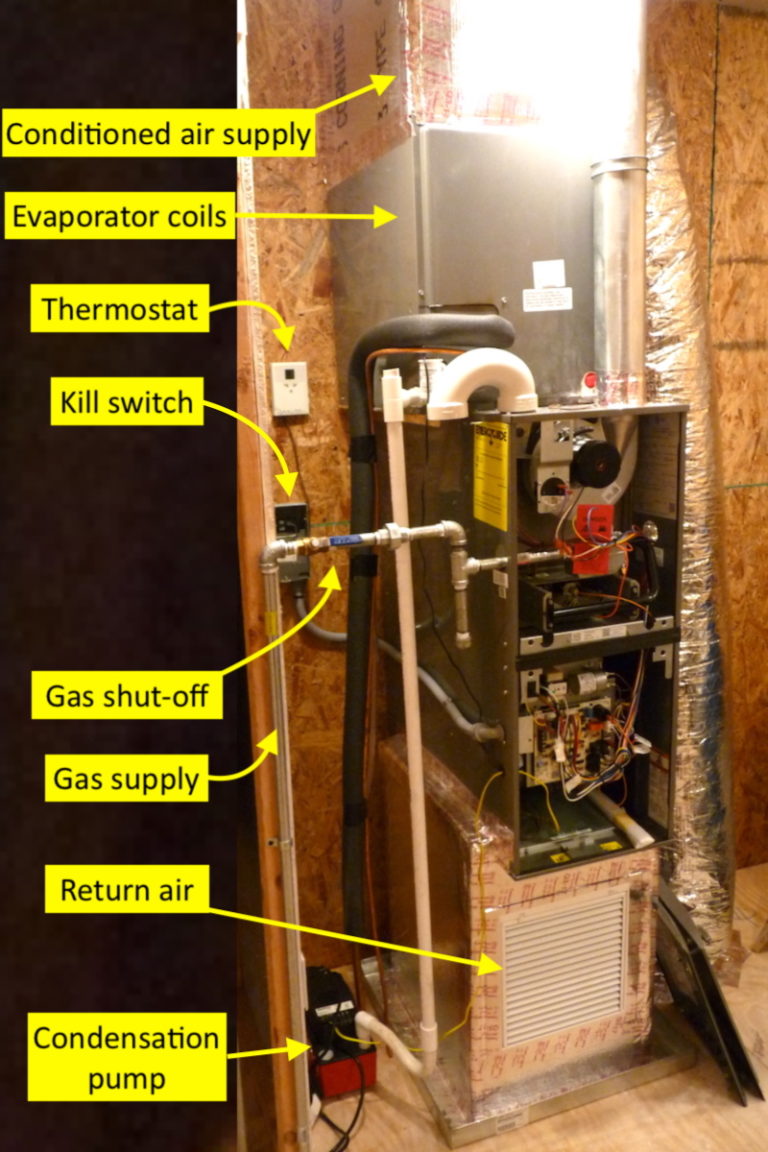
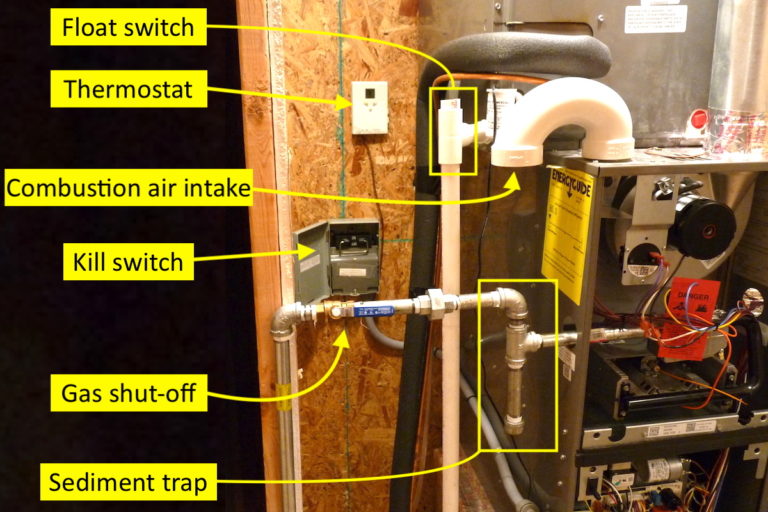
GENERAL OPERATION
Heating
When the thermostat calls for heat:
Gas travels from the supply, through the shut-off valve and past the sediment trap.
- The sediment trap causes gas to change direction, which in turn causes any particles and moisture droplets to fall into the vertical leg.
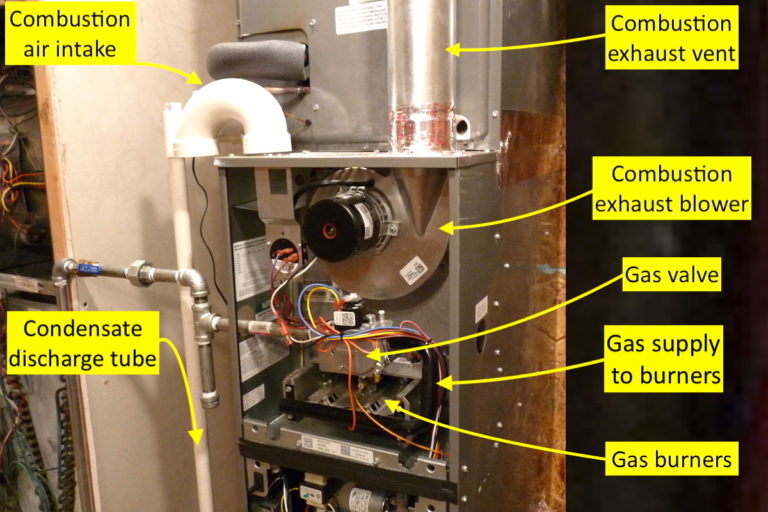
From the supply pipe, gas enters the gas valve.
- The gas valve opens and closes, controlling gas to the burners and to the pilot light (on older gas appliances). It opens gas supply valves to the pilot light/burners when the thermostat calls for heat, and closes the valves when the desired temperature is reached.
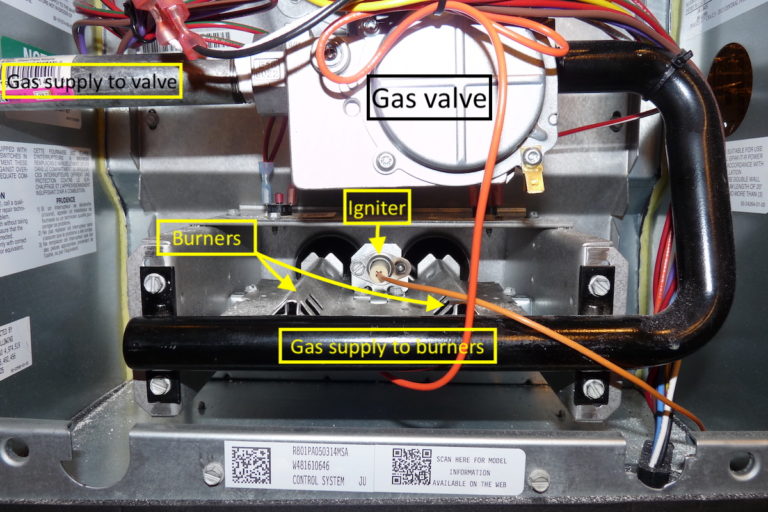
The burners heat air in the heat exchanger. This toxic products of combustion are then exhausted to the building exterior through the combustion exhaust vent.
- Newer gas appliances use a small blower to exhaust the products of combustion. With older appliances, the hot exhaust gas was vented through thermal buoyancy (hot air rises). These older appliances- furnaces and water heaters- were called “atmospheric”. Newer appliances employ “sealed” combustion exhaust, old appliances employ atmospheric combustion exhaust.
When the heat exchanger has reached a pre-set temperature, a signal from a sensor will activate the blower, which blows air from inside the home past the heat exchanger. As it flows past the hot heat exchanger, the home air absorbs heat.
From the furnace the blower pushes the heated air through supply air ducts to supply registers located at different parts of the home.
At the same time, air is pulled from the home interior through return air registers and flows through return air ducts to be filtered and re-heated.
When the thermostat senses that the desired temperature has been reached, it shuts off the flow of gas to the furnace burners, but the main blower will continue to operated until the heat exchanger has cooled to a pre-set temperature.
Cooling
When the thermostat calls for cooling:
Cold refrigerant flows through an insulated copper tube (the “suction line”) from the compressor unit at the home exterior to the evaporator coils housed in a metal cabinet at the furnace.
- The evaporator coils are typically located on the airflow downstream side of the heat exchanger.
The blower at the furnace activates, and home air flows past the evaporator coils.
- As air flows around the coils, the cold refrigerant circulating through the coils absorbs heat from that air.
- The tube carrying heat refrigerant is smaller than the suction line and is not insulated.
The heated refrigerant liquid returns to the exterior unit where it is first compress, to raise its temperature, and then circulated through coils. The fan pulls across the coils, dissipating the heat given off by the refrigerant.
- The refrigerant may be filtered and dried before it enters the exterior unit. The filter is a canister type installed in the smaller line.
From the coils, an expansion valve reduces refrigerant pressure to help lower its temperature even more before it again returns to the home through the suction line.
As warm air contacts the cold evaporator coils, some moisture condenses out of the air and flows down the coils to the base of the metal cabinet containing the coils.
- An outlet tube drains the liquid condensate from the cabinet. The condensate tube discharges to an acceptable location.
- Condensate may flow powered by gravity alone, or a pump may be installed. This furnace has a pump installed.
Defects
The union where the gas shut-off is located is brass, but is connected to galvanized steel pipes without a dielectric union. Dielectric unions are designed to electrically isolate different metals from each other in order to avoid galvanic corrosion, which can occur when different metals are in contact with each other in the presence of moisture. Recommend correction by a qualified contractor.
In the Crawlspace:
The condensate tube discharges into a plumbing drain pipe but no trap is installed in the condensate tube.
Observation
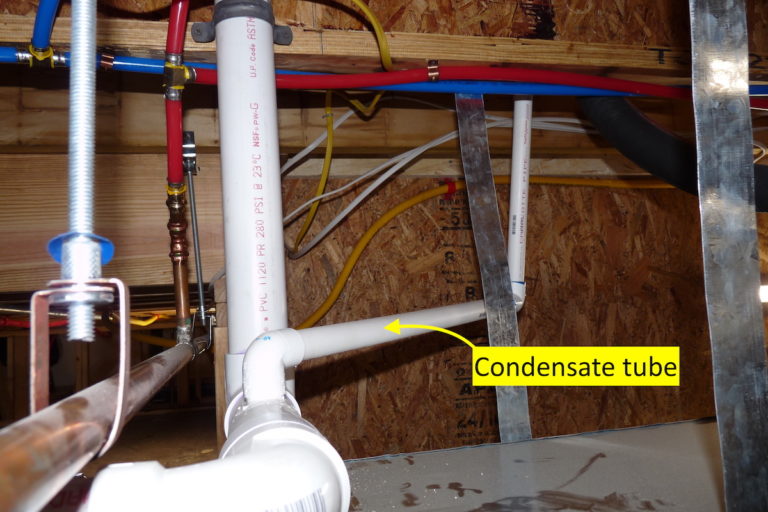
This condition may allow toxic sewer gas to enter the living space. Recommend correction by a qualified contractor.
Observation

An air supply duct in the crawlspace was disconnected at the register.
This is sometimes done intentionally in cold climates to keep water supply pipes from freezing, but it is always defective condition.
GAS WATER HEATER DEFECTS
Component Identification

Observation
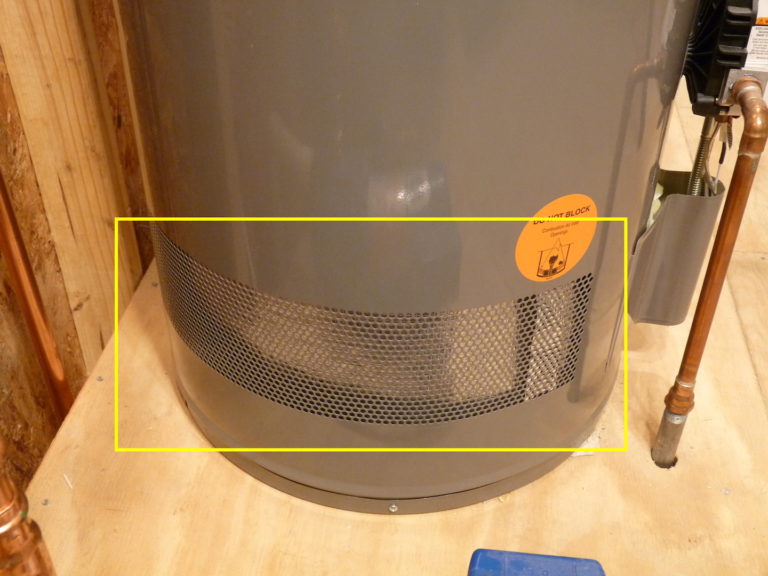
Fuel Vapor Ignition Resistant (FVIR) Water Heater
FVIR water heaters have a screen installed in the part of the jacket covering the burn chamber that is designed to prevent the ignition of flammable vapors that might be present near the water heater. An example is gasoline fumes from a gas can stored next to a water heater located in a basement or mechanical room.
Observation

Different metals in contact with no dielectric union.
In the presence of moisture, galvanic corrosion will occur when different metals are in contact with each other. To avoid galvanic corrosion, a dielectric union (a fitting of a non-conductive material) is installed that interrupts electrical conductivity between the pipes.
Observation
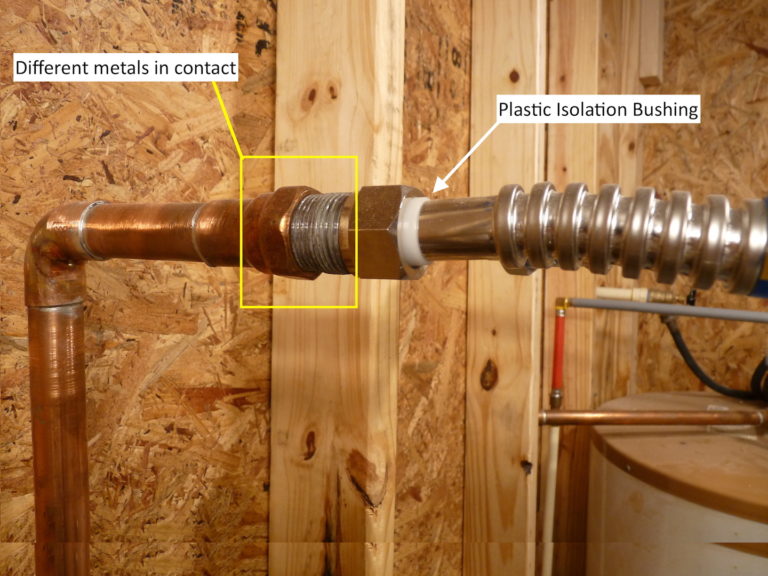
Improper dielectric union.
At the water supply pipe, although a dielectric union has been installed, two different metals are still in contact. Eventually, galvanic corrosion will cause a leak to develop at this fitting. The nipple connecting the two pipes should have been copper.
Observation

No gas shut-off or sediment trap.
A shut off should be installed to facilitate gas shut-off during an emergency, or for when the water heater is disconnected for replacement or repair.
A sediment trap is designed to keep particles out of the gas valve.
Observation

Temperature/Pressure relief (TPR) valve discharge pipe termination is not visible.
The termination of a TPR discharge pipes should be visible so that it can be visually verified that the end has not been capped or otherwise flow-restricted.
Observation
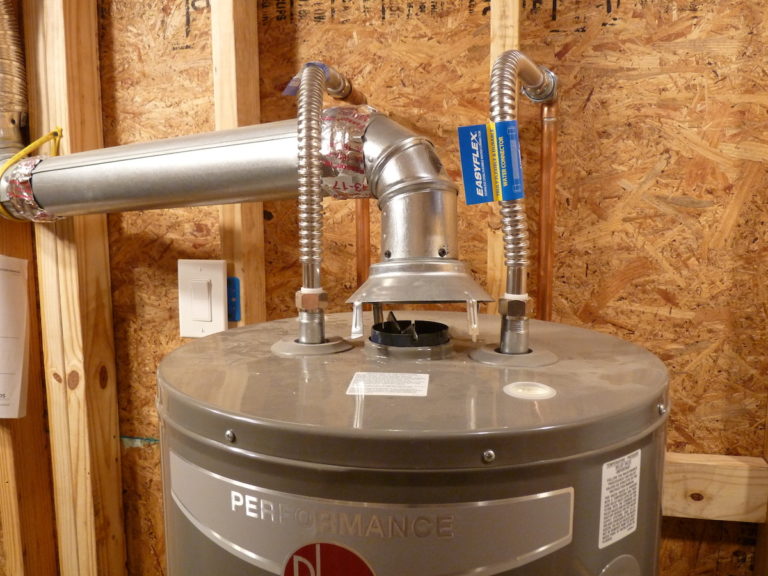
Disconnected draft hood.
The draft hood serves two purposes:
- It neutralizes stack effect by keeping the burn chamber at atmospheric pressure. In other words, it helps prevent excessive updrafts and downdrafts in the combustion exhaust vent that might affect the combustion process in the burn chamber.
- It provides dilution air. Dilution air lowers the temperature of combustion gases. Reducing the temperature difference between the hot combustion gasses and the cool exhaust vent also reduces the potential for the development of condensation that can corrode the vent and/or the water heater.
- It provides an avenue for exhaust spillage in the event of a blockage such as a bird’s nest.
Observation
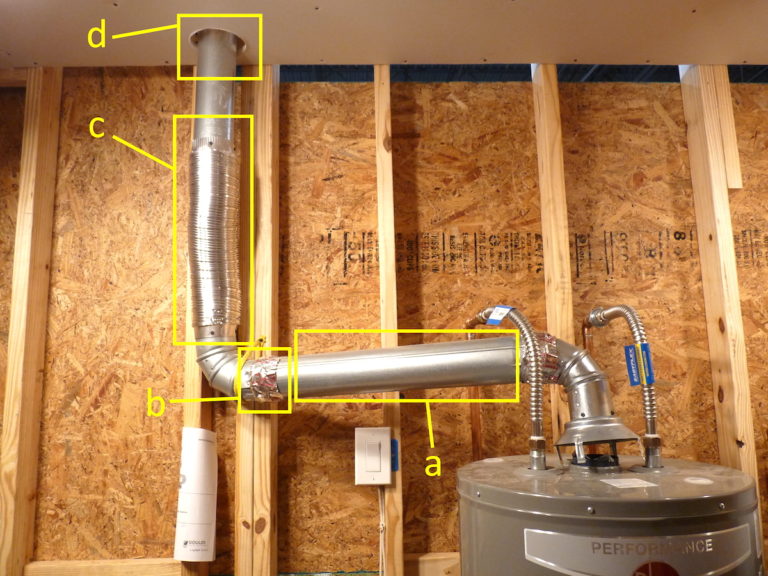
Improper exhaust vent configuration.
Reverse slope. The vent should slope up from the draft hood at and angle of at least ¼” vertical rise per foot of horizontal run.
Taped connections. In most jurisdictions, aluminum tape alone is not adequate for making connections, but may sometimes be installed to help hold screws in place.
Flexible, ribbed dryer vent is not an acceptable material for venting water heater combustion gasses. It is not designed to withstand the temperatures generated by gas combustion. Also, at any connection in which one section fits inside another, the lower section should be inserted inside the upper. The reverse has been done here.
Inadequate clearance for combustibles.
- Double-wall vent requires a 1-inch clearance from combustibles.
- Single wall vent requires 6-inch clearance from combustibles.
Observation
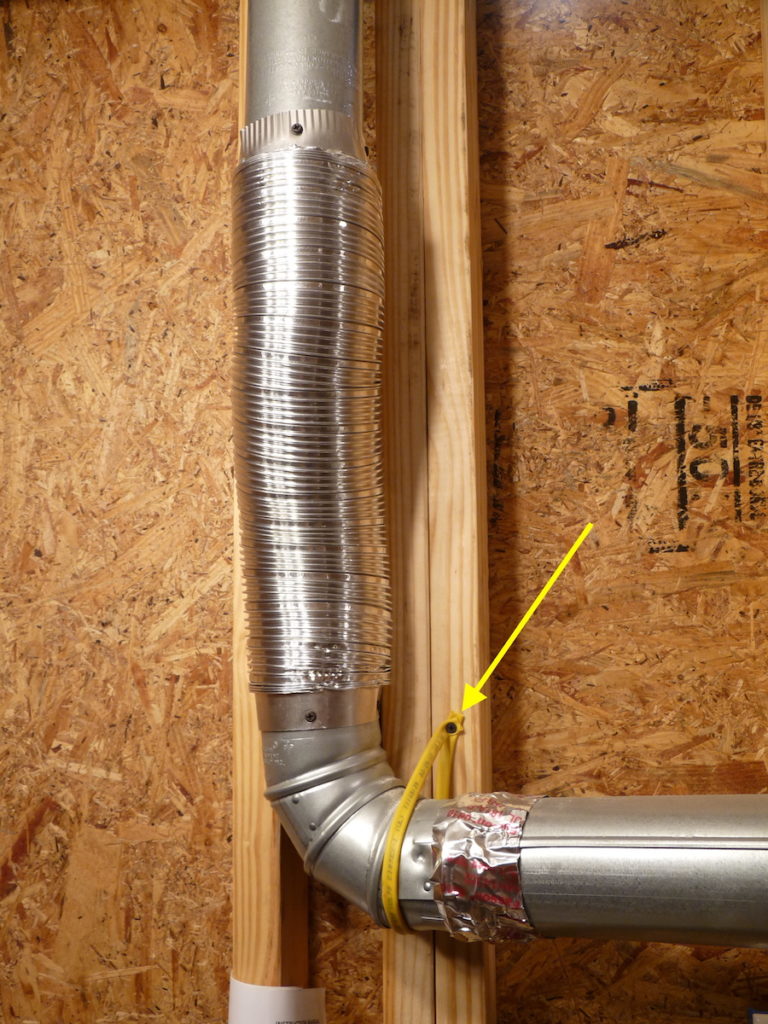
Improper vent support.
The metal vent should not be supported by a vinyl strap, which is combustible.
Observation
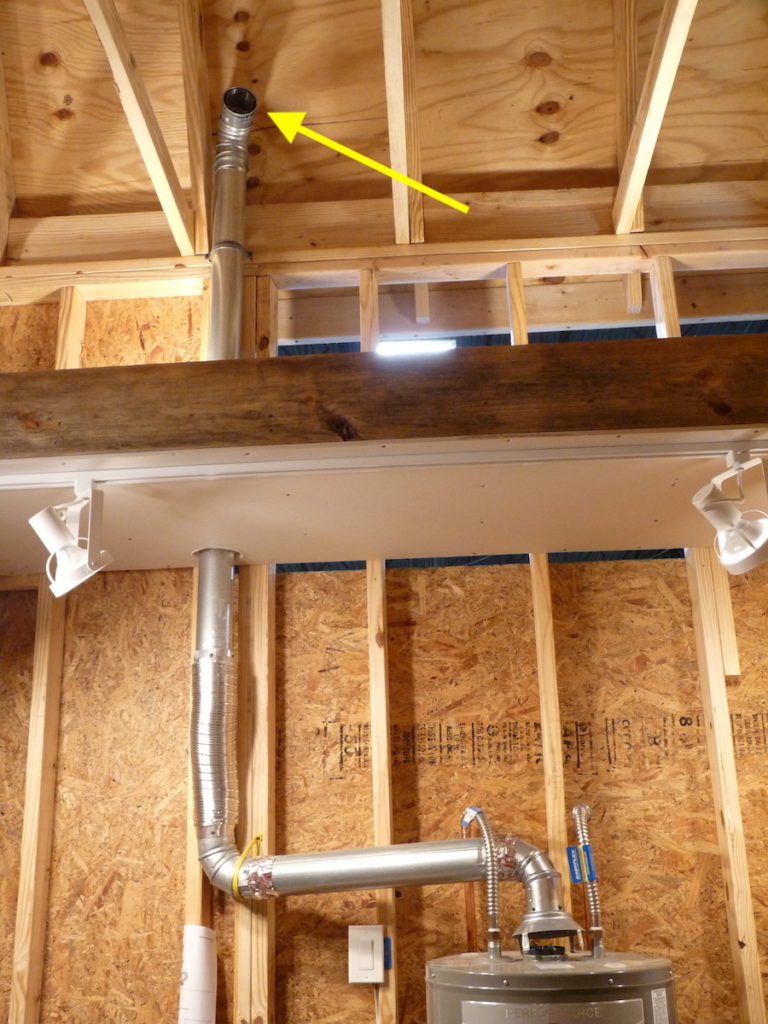
Combustion exhaust vent terminates in the attic.
This condition could allow the toxic products of combustion to enter the living space. All combustion vents must terminate “at” (not “near”) the exterior.
TITAN TANKLESS WATER HEATER

These small tankless water heaters have a reputation for often being installed incorrectly.
DEFECTS
No shut-off was installed on the cold water side.
No pressure relief valve was installed on the cold side between the shut-off and the heater.
Hot water supply pipe must be copper for the first 36” leaving the heater.
Improper fitting, copper to polyvinyl chloride (PVC).
PVC is not an acceptable material for hot water supply pipes.
AC COMPRESSOR UNDER STAIRS
Observation

It’s location in a confined space would reduce the ability of the AC unit to dissipate heat effectively.
Observation

The large, suction refrigerant line has insulation missing in various areas.
Areas where insulation is missing will allow the cold refrigerant to absorb heat from the outside air, which in turn will reduce its effectiveness in absorbing heat from the home interior air.
Observation

In the crawlspace, refrigerant lines are supported by improper materials.
